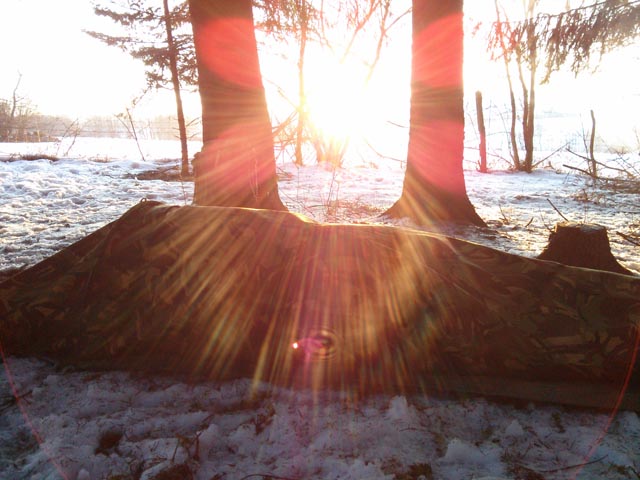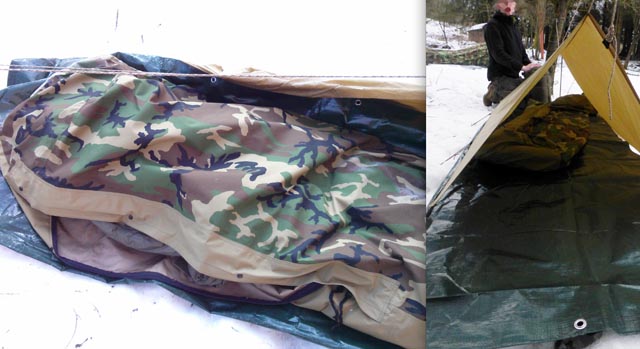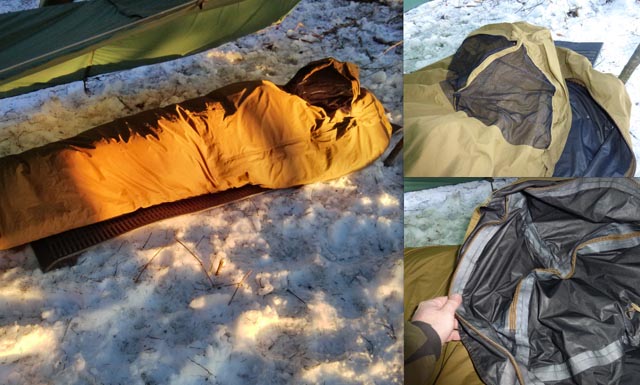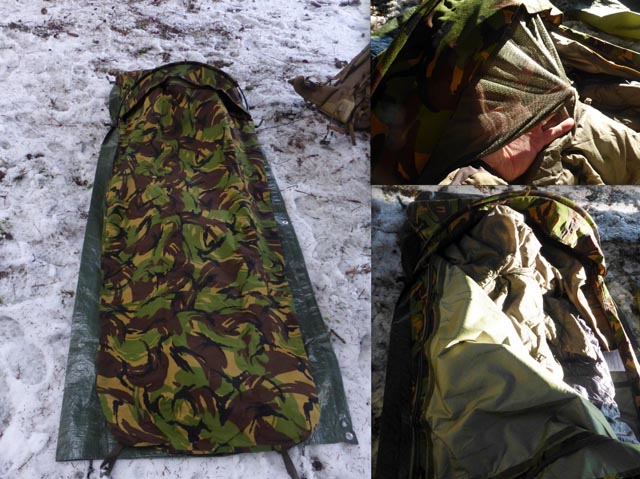Get the weekly SPARTANAT newsletter.
Your bonus: the free E-Book from SPARTANAT.

REVIEW: Battle of the Bivys - Part 1
Tents have been around for centuries in every imaginable form. From heavy cotton tents to Silnylon ultralight tents - each has its justification for existence, pros and cons, and of course its intended use. Strictly speaking, bivouac sacks are also tents. Just mostly for one person and usually just a shell around the sleeping bag to provide protection from rain, snow, wind, and insects. In today's time, bivouac sacks are made of ultra-thin and ultra-light materials to save weight, as tents or bivys, backpacks, and sleeping bags are the three biggest weight consumers when backpacking. Ultralight bivouac sacks essentially only serve the purpose of protecting the sleeping bag when sleeping under a tarp - so the tarp provides the actual rain protection. In the military field, bivys are usually heavier, but also more robust, and serve both camouflage purposes (a bivy has a flatter silhouette than a tent) and as the only weather protection, as a tarp is usually not used.
Since almost every country with a larger army provides a bivy in one form or another, we have compiled a selection of bivys available to us here. Only models that are largely fully closable were selected. Furthermore, we tried to make the selection as broad as possible in terms of weight, size, and price. Of course, there are also cheaper models that are limited to the minimum - for example, the British bivouac sack, which only has a drawstring at the head and no zipper - but we specifically wanted to present the somewhat "more comfortable" bivouac sacks and not start a discussion about which one is THE bivouac sack. Everything has its advantages and disadvantages.
At the end of the second part of the article, you will find a comparison table with the most important facts.
 The first one is the somewhat aging but still useful US Army Bivouac Sack. This is issued as a complete system with two sleeping bags (summer/winter) and a pack sack (US Army MSS - Modular Sleep System) and in this package, it is quite heavy and has a pitifully small pack size. The bivy itself, however, is quite decent in weight (1020 grams) and provides good protection for rough handling and bad weather with its robust outer shell and Goretex laminate. Furthermore, it is quite generously cut and offers space for one person and some equipment, you should also be able to fit a sleeping mat inside. Unlike any other model presented here, the US Army Bivy does not have mosquito protection, which is clearly a disadvantage in summer. As a result, the zipper is not completely closable to allow for some air circulation. While you can breathe through Goretex, you would rather not try it out before suffocating. The zipper is truly built to last and extremely sturdy, additionally protected by a flap with snap buttons. Many users swear by the US Army Bivy because it is cheap and ultra-robust - the perfect entry-level option in the military sector. You can get the US Army Bivy in the good old Woodland Camo and the unusable ACU for the best price starting at 50€ on Ebay.
The first one is the somewhat aging but still useful US Army Bivouac Sack. This is issued as a complete system with two sleeping bags (summer/winter) and a pack sack (US Army MSS - Modular Sleep System) and in this package, it is quite heavy and has a pitifully small pack size. The bivy itself, however, is quite decent in weight (1020 grams) and provides good protection for rough handling and bad weather with its robust outer shell and Goretex laminate. Furthermore, it is quite generously cut and offers space for one person and some equipment, you should also be able to fit a sleeping mat inside. Unlike any other model presented here, the US Army Bivy does not have mosquito protection, which is clearly a disadvantage in summer. As a result, the zipper is not completely closable to allow for some air circulation. While you can breathe through Goretex, you would rather not try it out before suffocating. The zipper is truly built to last and extremely sturdy, additionally protected by a flap with snap buttons. Many users swear by the US Army Bivy because it is cheap and ultra-robust - the perfect entry-level option in the military sector. You can get the US Army Bivy in the good old Woodland Camo and the unusable ACU for the best price starting at 50€ on Ebay.
 Next comes the model of the US Marine Corps (previously featured here). The Corps also had the MSS in use and a few years ago switched to the "Improved 3 Season Sleep System," which includes the Improved Bivy Cover. The set now consists of just a sleeping bag + pack sack, as the Corps includes the clothing of the Marines from Level 1-7 when it comes to cold. Therefore, one should be able to use a relatively thin sleeping bag with a Level 7 jacket + pants even in crisp minus temperatures, and thus saved a sleeping bag compared to the MSS. The brand name Goretex does not appear on the label, here it refers to a PTFE membrane - which should be roughly the same. Compared to its predecessor, the sack has become slightly lighter (about 100 grams), but also much narrower - a winter sleeping mat with about 6cm and a thick sleeping bag will only fit if you sleep on your back. However, it has been given a little more length and a mosquito net. This can be set up with a wire frame so that it does not lie on your face and becomes useless. The material is slightly thinner than that of the MSS Bivy and appears more delicate, but the ripstop outer skin should be able to withstand a lot. The bivy can be opened only 3/4, weight was saved on the zipper, but it also makes it a bit more difficult to get out. At the foot end, there are two loops with which you can fix the sack to the ground or hang it up to dry. All in all, this bivy is an improvement over its predecessor and is now also available on Ebay (sometimes) at good prices. It is only available in USMC Coyote Brown.
Next comes the model of the US Marine Corps (previously featured here). The Corps also had the MSS in use and a few years ago switched to the "Improved 3 Season Sleep System," which includes the Improved Bivy Cover. The set now consists of just a sleeping bag + pack sack, as the Corps includes the clothing of the Marines from Level 1-7 when it comes to cold. Therefore, one should be able to use a relatively thin sleeping bag with a Level 7 jacket + pants even in crisp minus temperatures, and thus saved a sleeping bag compared to the MSS. The brand name Goretex does not appear on the label, here it refers to a PTFE membrane - which should be roughly the same. Compared to its predecessor, the sack has become slightly lighter (about 100 grams), but also much narrower - a winter sleeping mat with about 6cm and a thick sleeping bag will only fit if you sleep on your back. However, it has been given a little more length and a mosquito net. This can be set up with a wire frame so that it does not lie on your face and becomes useless. The material is slightly thinner than that of the MSS Bivy and appears more delicate, but the ripstop outer skin should be able to withstand a lot. The bivy can be opened only 3/4, weight was saved on the zipper, but it also makes it a bit more difficult to get out. At the foot end, there are two loops with which you can fix the sack to the ground or hang it up to dry. All in all, this bivy is an improvement over its predecessor and is now also available on Ebay (sometimes) at good prices. It is only available in USMC Coyote Brown.
 In the middle of our round is the so-called Hooped Bivy of the Dutch Army. It is mid-range in terms of weight and price, but not in terms of equipment. Goretex is used here, manufactured by Carinthia (or - as presented here - under license from a Spanish company named Fecsa) and comes in DPM camouflage of the Dutch army. The Carinthia model is available as the "Explorer two" and costs a lot more. Carinthia only offers it in Olive Green. The Hooped Bivy gets its name from the hoop used in the head area - here is a half ring, which stands freely when the bivy is fixed with pegs at the ground, providing a lot of headroom. There is also a mosquito net for good ventilation and insect protection. You can move around in the sack without anything falling or shifting, promising a very good sleeping comfort. The Dutch offer two lengths to choose from - Large (seen here) with 240cm and XLarge with 270cm. A 1.80 tall person can comfortably store a medium-sized backpack even with the shorter version in the foot area and protect the gear. There is also some space on the right and left, and a thick sleeping mat fits easily below. In terms of robustness, the Hooped Bivy would be on par with the MSS Bivy, they are neck and neck when it comes to rough use. The attractive feature of this model is the price - usually found on Ebay starting at 80 euros, providing a "carefree package" with a small packing size, moderate weight, and good comfort.
In the middle of our round is the so-called Hooped Bivy of the Dutch Army. It is mid-range in terms of weight and price, but not in terms of equipment. Goretex is used here, manufactured by Carinthia (or - as presented here - under license from a Spanish company named Fecsa) and comes in DPM camouflage of the Dutch army. The Carinthia model is available as the "Explorer two" and costs a lot more. Carinthia only offers it in Olive Green. The Hooped Bivy gets its name from the hoop used in the head area - here is a half ring, which stands freely when the bivy is fixed with pegs at the ground, providing a lot of headroom. There is also a mosquito net for good ventilation and insect protection. You can move around in the sack without anything falling or shifting, promising a very good sleeping comfort. The Dutch offer two lengths to choose from - Large (seen here) with 240cm and XLarge with 270cm. A 1.80 tall person can comfortably store a medium-sized backpack even with the shorter version in the foot area and protect the gear. There is also some space on the right and left, and a thick sleeping mat fits easily below. In terms of robustness, the Hooped Bivy would be on par with the MSS Bivy, they are neck and neck when it comes to rough use. The attractive feature of this model is the price - usually found on Ebay starting at 80 euros, providing a "carefree package" with a small packing size, moderate weight, and good comfort.
To be continued
SPARTANAT is the online magazine for Military News, Tactical Life, Gear & Reviews.
Send us your news: [email protected]
Ad
similar
Get the weekly SPARTANAT newsletter.
Your bonus: the free E-Book from SPARTANAT.


